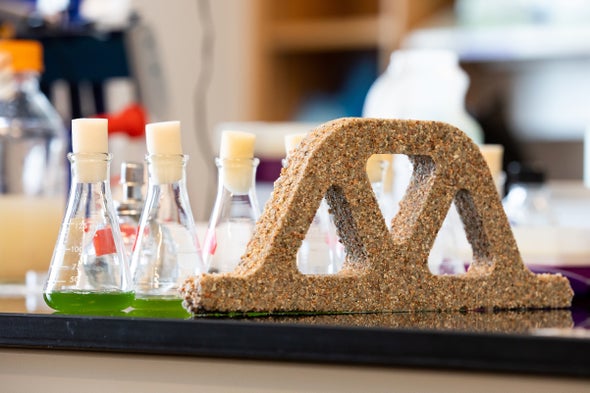These living bricks use bacteria to build themselves

The big idea: A new living substance can transform from a wet sand mixture into a solid brick, and even help to reproduce copies of itself.
How it was created: Researchers from the University of Colorado, Boulder, used a type of photosynthetic bacteria that absorbs carbon dioxide, sunlight, and nutrients and produces calcium carbonate—a rigid compound found in rocks, pearls, and seashells. They grew the bacteria in a warm mixture of salt water and other nutrients and combined it with sand and gelatin. The mixture was poured into a mold, and as it cooled the gelatin set, forming a “scaffold” able to support further bacterial growth. The bacteria deposited calcium carbonate throughout the scaffold, turning the soft sludge into a harder substance after about a day. The mixture looks green initially, but the color fades as it dries. The research was published in the journal Matter and was funded by DARPA, the US military's research arm.
Testing: The team cut the material into two-inch cubes and found they were strong enough for someone to stand on without shattering, although the material isn’t as strong as conventional concrete. Shoe-box-size blocks could potentially be strong enough for use as bricks in construction.
The potential: A major benefit of the new material, the researchers say, is that the whole process revolves around bacteria: they help build the bricks, and are kept alive so they are able to produce more bricks later on. The material could be useful for construction in inhospitable environments like the desert, or even space. It’s also a low-carbon alternative to concrete that could be used to make buildings that absorb greenhouse gases rather than releasing them.
Sign up here to our daily newsletter The Download to get your dose of the latest must-read news from the world of emerging tech.
Deep Dive
Biotechnology and health
How scientists traced a mysterious covid case back to six toilets
When wastewater surveillance turns into a hunt for a single infected individual, the ethics get tricky.
An AI-driven “factory of drugs” claims to have hit a big milestone
Insilico is part of a wave of companies betting on AI as the "next amazing revolution" in biology
The quest to legitimize longevity medicine
Longevity clinics offer a mix of services that largely cater to the wealthy. Now there’s a push to establish their work as a credible medical field.
There is a new most expensive drug in the world. Price tag: $4.25 million
But will the latest gene therapy suffer the curse of the costliest drug?
Stay connected
Get the latest updates from
MIT Technology Review
Discover special offers, top stories, upcoming events, and more.